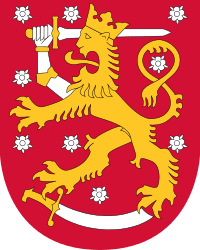Administrative divisions of Finland
| Part of a series on |
| Subdivisions of Finland |
|---|
| Regions |
| Sub-regions |
| Municipalities |
 |
| This article is part of a series on the politics and government of Finland |
|
Legislative
|
|
|
As of 2016, Finland is divided into:
- 19 regions (Finnish maakunta, Swedish landskap)[1]
- the regions are divided into 70 sub-regions (Finnish seutukunta, Swedish ekonomisk region)[2]
- the sub-regions are divided into 313 municipalities (Finnish kunta, Swedish kommun).[3]
Description

Black borders refer to municipalities, red to regions.
Municipalities (which may also call themselves towns or cities) account for half of public spending. Spending is financed by municipal income tax, state subsidies, and other revenue. As of 2008, there were 415 municipalities, and most were under 5,000 residents. For comparison, Denmark has set a minimum size of 30,000 residents. In Finland, state has started the Municipality and Service Structure Reform Program to reform the complex and expensive municipal system, but initiatives have encountered much opposition from local bureaucrats and interest groups. People often identify with their municipality. Government's local administrative duties are performed by the Regional State Administrative Agencies.
In addition to municipalities, there are complex other arrangements. Municipalities co-operate in seventy-four sub-regions and twenty regions. These are governed by the member municipalities. The Åland region has a permanent, democratically elected regional council, as a part of the autonomy. In the Kainuu region, there is a pilot project underway, with regional elections. Sami people have a semi-autonomous Sami Domicile Area in Lapland for issues on language and culture.
In the following chart, the number of inhabitants includes those living in the entire municipality (kunta/kommun), not just in the built-up area. The land area is given in km², and the density in inhabitants per km² (land area). The figures are as of January 1, 2007. Notice that the capital region – comprising Helsinki, Vantaa, Espoo and Kauniainen (see Greater Helsinki) – forms a continuous conurbation of one million people. However, common administration is limited to voluntary cooperation of all municipalities, e.g. in Helsinki Metropolitan Area Council.
| Municipality | Population | Land area | Density |
|---|---|---|---|
| Helsinki | 564,474 | 184.47 | 3,061.00 |
| Espoo | 235,100 | 312.00 | 751.60 |
| Tampere | 206,171 | 523.40 | 393.90 |
| Vantaa | 189,442 | 240.54 | 780.40 |
| Turku | 177,502 | 243.40 | 720.50 |
| Oulu | 130,049 | 369.43 | 351.40 |
| Lahti | 98,773 | 134.95 | 730.10 |
| Kuopio | 91,026 | 1,127.40 | 81.00 |
| Jyväskylä | 84,482 | 105.90 | 789.00 |
| Pori | 76,211 | 503.17 | 150.83 |
| Lappeenranta | 59,077 | 758.00 | 77.70 |
| Rovaniemi | 58,100 | 7,600.73 | 7.60 |
| Joensuu | 57,879 | 1,173.40 | 49.10 |
| Vaasa | 57,266 | 183.00 | 311.20 |
| Kotka | 54,860 | 270.74 | 203.00 |
- Further information: List of Finnish municipalities, List of Finnish municipalities by population, List of Finnish municipalities by area, and Former municipalities of Finland
References
- ↑ "Regions and municipalities". Suomi.fi. 2016-01-01. Retrieved 2016-04-29.
- ↑ http://www.tilastokeskus.fi/meta/luokitukset/seutukunta/001-2013/index_en.html
- ↑ "Kaupunkien ja kuntien lukumäärä". Kunnat (in Finnish). 2016-01-01. Retrieved 2016-04-29.